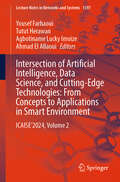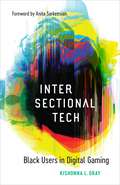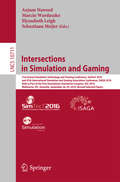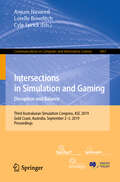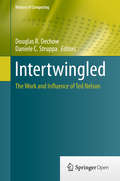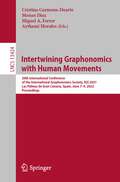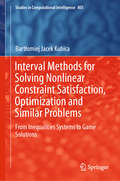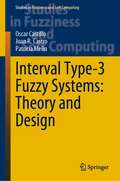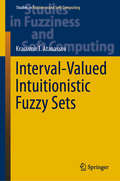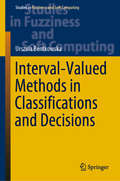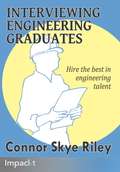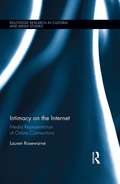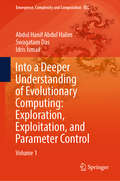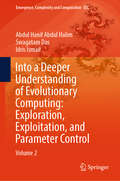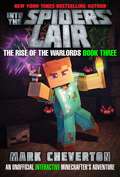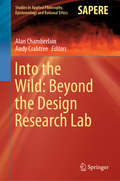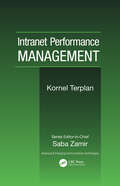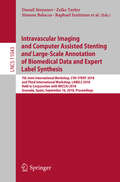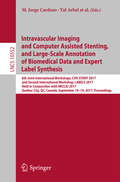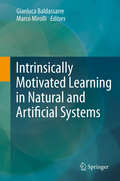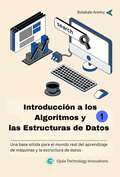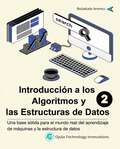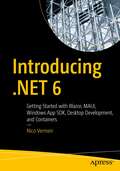- Table View
- List View
Intersection of Artificial Intelligence, Data Science, and Cutting-Edge Technologies: ICAISE’2024, Volume 2 (Lecture Notes in Networks and Systems #1397)
by Tutut Herawan Yousef Farhaoui Agbotiname Lucky Imoize Ahmad El AllaouiOffering a comprehensive exploration, this book navigates through foundational concepts to advanced applications, providing readers with a holistic understanding of how these domains intersect to create intelligent and responsive environments. The Intersection of Artificial Intelligence, Data Science, and Cutting-Edge Technologies: From Concepts to Applications in Smart Environments delves into the convergence of AI, data science, and innovative technologies within the realm of smart environments. Through a blend of theoretical insights and practical examples, the book illuminates the synergies between AI and data science, showcasing their pivotal roles in shaping the future of smart environments. From sensor technologies to machine learning algorithms, the text elucidates the mechanisms driving intelligence in these environments, while also delving into the ethical considerations and societal impacts of deploying such technologies. Whether you're a researcher, practitioner, or enthusiast in the fields of AI, data science, or smart environments, this book serves as a guiding beacon, offering valuable insights and methodologies to navigate the complexities of creating and optimizing intelligent environments for the benefit of society.
Intersectional Tech: Black Users in Digital Gaming
by Kishonna L. GrayIn Intersectional Tech: Black Users in Digital Gaming, Kishonna L. Gray interrogates blackness in gaming at the intersections of race, gender, sexuality, and (dis)ability. Situating her argument within the context of the concurrent, seemingly unrelated events of Gamergate and the Black Lives Matter movement, Gray highlights the inescapable chains that bind marginalized populations to stereotypical frames and limited narratives in video games. Intersectional Tech explores the ways that the multiple identities of black gamers—some obvious within the context of games, some more easily concealed—affect their experiences of gaming. The normalization of whiteness and masculinity in digital culture inevitably leads to isolation, exclusion, and punishment of marginalized people. Yet, Gray argues, we must also examine the individual struggles of prejudice, discrimination, and microaggressions within larger institutional practices that sustain the oppression. These “new” racisms and a complementary colorblind ideology are a kind of digital Jim Crow, a new mode of the same strategies of oppression that have targeted black communities throughout American history. Drawing on extensive interviews that engage critically with identity development and justice issues in gaming, Gray explores the capacity for gaming culture to foster critical consciousness, aid in participatory democracy, and effect social change. Intersectional Tech is rooted in concrete situations of marginalized members within gaming culture. It reveals that despite the truths articulated by those who expose the sexism, racism, misogyny, and homophobia that are commonplace within gaming communities, hegemonic narratives continue to be privileged. This text, in contrast, centers the perspectives that are often ignored and provides a critical corrective to notions of gaming as a predominantly white and male space.
Intersections in Simulation and Gaming: 21st Annual Simulation Technology And Training Conference, Simtect 2016, And 47th International Simulation And Gaming Association Conference, Isaga 2016, Held As Part Of The First Australasian Simulation Congress, Asc 2016, Melbourne, Vic, Australia, September 26-29, 2016, Revised Selected Papers (Lecture Notes in Computer Science #10711)
by Anjum Naweed Marcin Wardaszko Elyssebeth Leigh Sebastiaan MeijerThis book constitutes the refereed post-conference proceedings of the 21st Annual Simulation Technology and Training Conference, SimTecT 2016, and the 47th International Simulation and Gaming Association Conference, ISAGA 2016, Held as Part of the First Australasian Simulation Congress, ASC 2016, held in Melbourne, VIC, Australia, in September 2016. The 28 revised full papers included in the volume were carefully reviewed and selected from 55 submissions. They are organized in the following topical sections: Making the grade; Come to think of it; From here to fidelity; The name of the game; and Ahead of the game.
Intersections in Simulation and Gaming: Third Australasian Simulation Congress, ASC 2019, Gold Coast, Australia, September 2–5, 2019, Proceedings (Communications in Computer and Information Science #1067)
by Anjum Naweed Lorelle Bowditch Cyle SprickThis book constitutes the refereed proceedings of the Australasian Simulation Congress, ASC 2019, held in Gold Coast, Australia in September 2019. The 10 papers presented were carefully reviewed and selected from 17 submissions. They provide a forum for sharing progresses in the areas of human dimensions; gaming experience; design and application; search and rescue; defence-oriented technology and training.
Intertwingled
by Daniele C. Struppa Douglas R. DechowThis engaging volume celebrates the life and work of Theodor Holm "Ted" Nelson, a pioneer and legendary figure from the history of early computing. Presenting contributions from world-renowned computer scientists and figures from the media industry, the book delves into hypertext, the docuverse, Xanadu and other products of Ted Nelson's unique mind. Features: includes a cartoon and a sequence of poems created in Nelson's honor, reflecting his wide-ranging and interdisciplinary intellect; presents peer histories, providing a sense of the milieu that resulted from Nelson's ideas; contains personal accounts revealing what it is like to collaborate directly with Nelson; describes Nelson's legacy from the perspective of his contemporaries from the computing world; provides a contribution from Ted Nelson himself. With a broad appeal spanning computer scientists, science historians and the general reader, this inspiring collection reveals the continuing influence of the original visionary of the World Wide Web.
Intertwining Graphonomics with Human Movements: 20th International Conference of the International Graphonomics Society, IGS 2021, Las Palmas de Gran Canaria, Spain, June 7-9, 2022, Proceedings (Lecture Notes in Computer Science #13424)
by Aythami Morales Cristina Carmona-Duarte Moises Diaz Miguel A. FerrerThis book constitutes the proceedings of the 20th International Conference of the International Graphonomics Society, IGS 2021/2022. Originally planned to be celebrated in September 2021, due to the COVID-19 pandemic it was held in June 2022.The 36 full and 3 short papers presented at the conference were carefully reviewed and selected from 41 submissions and reviewed by a committee of 67 reviewers. Out of the 41 conferences, 26 papers were selected to be published in this proceedings. The program was comprised of 6 oral sessions on the following topics: historical documents, forensic handwriting examinations, handwriting learning and development, and motor control. One additional poster session included papers on all previous topics, and three special sessions included papers on neurodegenerative disorders.
Interval Methods for Solving Nonlinear Constraint Satisfaction, Optimization and Similar Problems: From Inequalities Systems to Game Solutions (Studies in Computational Intelligence #805)
by Bartłomiej Jacek KubicaThis book highlights recent research on interval methods for solving nonlinear constraint satisfaction, optimization and similar problems. Further, it presents a comprehensive survey of applications in various branches of robotics, artificial intelligence systems, economics, control theory, dynamical systems theory, and others. Three appendices, on the notation, representation of numbers used as intervals’ endpoints, and sample implementations of the interval data type in several programming languages, round out the coverage.
Interval Type-3 Fuzzy Systems: Theory and Design (Studies in Fuzziness and Soft Computing #418)
by Oscar Castillo Patricia Melin Juan R. CastroThis book briefly reviews the basic concepts of type-2 fuzzy systems and then describes the proposed definitions for interval type-3 fuzzy sets and relations, also interval type-3 inference and systems. The use of type-2 fuzzy systems has become widespread in the leading economy sectors, especially in industrial and application areas, such as services, health, defense, and so on. However, recently the use of interval type-3 fuzzy systems has been receiving increasing attention and some successful applications have been developed in the last year. These issues were taken into consideration for this book, as we did realize that there was a need to offer the main theoretical concepts of type-3 fuzzy logic, as well as methods to design, develop and implement the type-3 fuzzy systems. A review of basic concepts and their use in the design and implementation of interval type-3 fuzzy systems, which are relatively new models of uncertainty and imprecision, are presented. The main focus of this work is based on the basic reasons of the need for interval type-3 fuzzy systems in different areas of application. In addition, we describe methods for designing interval type-3 fuzzy systems and illustrate this with some examples and simulations.
Interval-Valued Intuitionistic Fuzzy Sets (Studies in Fuzziness and Soft Computing #388)
by Krassimir T. AtanassovThe book offers a comprehensive survey of interval-valued intuitionistic fuzzy sets. It reports on cutting-edge research carried out by the founder of the intuitionistic fuzzy sets, Prof. Krassimir Atanassov, giving a special emphasis to the practical applications of this extension. A few interesting case studies, such as in the area of data mining, decision making and pattern recognition, among others, are discussed in detail.The book offers the first comprehensive guide on interval-valued intuitionistic fuzzy sets. By providing the readers with a thorough survey and important practical details, it is expected to support them in carrying out applied research and to encourage them to test the theory behind the sets for new advanced applications. The book is a valuable reference resource for graduate students and researchers alike.
Interval-Valued Methods in Classifications and Decisions (Studies in Fuzziness and Soft Computing #378)
by Urszula BentkowskaThis book describes novel algorithms based on interval-valued fuzzy methods that are expected to improve classification and decision-making processes under incomplete or imprecise information. At first, it introduces interval-valued fuzzy sets. It then discusses new methods for aggregation on interval-valued settings, and the most common properties of interval-valued aggregation operators. It then presents applications such as decision making using interval-valued aggregation, and classification in case of missing values. Interesting applications of the developed algorithms to DNA microarray analysis and in medical decision support systems are shown. The book is intended not only as a timely report for the community working on fuzzy sets and their extensions but also for researchers and practitioners dealing with the problems of uncertain or imperfect information.
Interviewing Engineering Graduates
by Connor Skye RileyA strong engineering team is the backbone of any technical company, and smart managers are always looking to hire top talent. Recruiting and interviewing engineers in a smart way is essential to the growth of your team and your company. In this saturated hiring market, your positions must stand out among the big name companies, and your hiring processes must be rigorous, fair and efficient. This comprehensive guide will show you how to hire outstanding technical employees. With its step-by-step instructions and examples, Interviewing Engineering Graduates will take you all the way through the process, from attracting great candidates to making hiring decisions with confidence. Hiring engineers is a complex, expensive and crucial process. This book will get you organized quickly and prepare you to make the right decisions every step of the way. First, you’ll see how to market your open jobs effectively through writing amazing job descriptions, and selling your company to top engineers so that you get the best applicants. You’ll then learn to narrow the field by identifying the best resumes. Using our tips, tricks and templates, you can design, plan and prepare thoroughly for smooth running, multi-stage assessments and interviews. Finally, you’ll easily identify which engineers will be top performers for your company, get your whole team involved in the hiring decision, and clinch that final offer! Whatever your company and whatever type of engineering job you’re hiring for, with this book you can hire employees with the technical savvy and teamwork skills to help take your organization to the next level.
Interviewing Users
by Steve PortigalInterviewing is a foundational user research tool that people assume they already possess. Everyone can ask questions, right? Unfortunately, that's not the case. Interviewing Users provides invaluable interviewing techniques and tools that enable you to conduct informative interviews with anyone. You'll move from simply gathering data to uncovering powerful insights about people.
Intimacy on the Internet: Media Representations of Online Connections (Routledge Research in Cultural and Media Studies)
by Lauren RosewarneThe focus of this book is on the media representations of the use of the Internet in seeking intimate connections—be it a committed relationship, a hook-up, or a community in which to dabble in fringe sexual practices. Popular culture (film, narrative television, the news media, and advertising) present two very distinct pictures of the use of the Internet as related to intimacy. From news reports about victims of online dating, to the presentation of the desperate and dateless, the perverts and the deviants, a distinct frame for the intimacy/Internet connection is negativity. In some examples however, a changing picture is emerging. The ubiquitousness of Internet use today has meant a slow increase in comparatively more positive representations of successful online romances in the news, resulting in more positive-spin advertising and a more even-handed presence of such liaisons in narrative television and film. Both the positive and the negative media representations are categorised and analysed in this book to explore what they reveal about the intersection of gender, sexuality, technology and the changing mores regarding intimacy.
Into a Deeper Understanding of Evolutionary Computing: Volume 1 (Emergence, Complexity and Computation #50)
by Swagatam Das Abdul Hanif Abdul Halim Idris IsmailThis book delves into fundamental and advanced strategies for enhancing evolutionary and metaheuristic algorithms, focusing on the crucial balance between exploration and exploitation in search mechanisms. As technological advancements increase optimization complexity, effectively managing this balance becomes essential for achieving optimal solutions within reasonable computational resources. The book's distinctive structure organizes content according to optimization stages and processes, offering a comprehensive discussion of various approaches supported by extensive literature. The authors note a scarcity of literature addressing the trade-offs between exploration and exploitation with contemporary references, making this work particularly valuable. It aims to deepen the reader's understanding of evolutionary computing, emphasizing exploration, exploitation, and parameter control. It is relevant not only to algorithm developers and the evolutionary computation community but also to students and researchers across scientific disciplines. The book is designed to be accessible to those without extensive algorithm development backgrounds, providing theoretical and practical insights into optimization methods.
Into a Deeper Understanding of Evolutionary Computing: Volume 2 (Emergence, Complexity and Computation #51)
by Swagatam Das Abdul Hanif Abdul Halim Idris IsmailThis book delves into fundamental and advanced strategies for enhancing evolutionary and metaheuristic algorithms, focusing on the crucial balance between exploration and exploitation in search mechanisms. As technological advancements increase optimization complexity, effectively managing this balance becomes essential for achieving optimal solutions within reasonable computational resources. The book's distinctive structure organizes content according to optimization stages and processes, offering a comprehensive discussion of various approaches supported by extensive literature. The authors note a scarcity of literature addressing the trade-offs between exploration and exploitation with contemporary references, making this work particularly valuable. It aims to deepen the reader's understanding of evolutionary computing, emphasizing exploration, exploitation, and parameter control. It is relevant not only to algorithm developers and the evolutionary computation community but also to students and researchers across scientific disciplines. The book is designed to be accessible to those without extensive algorithm development backgrounds, providing theoretical and practical insights into optimization methods.
Into the Spiders' Lair: The Rise of the Warlords Book Three: An Unofficial Minecrafter's Adventure (Rise of the Warlords #3)
by Mark ChevertonThe witches of the Far Lands of Minecraft are missing . . . all of them! When a young village girl is badly injured, and only a witch can help her, Watcher and his friends quickly discover there are spiders involved. They must follow clues leading them through jungles and forests, all the way to the doorstep of the dreaded outcast spiders, the Forgotten. Watcher and his companions must figure out a way to free the witches from their ruthless captors, but can they escape the Lair of the Forgotten in time to save the girl?The Rise of the Warlords series is a Minecraft adventure like never before, giving fans the option to play along in Minecraft as they read on custom Far Lands worlds exclusively designed by bestselling author Mark Cheverton.
Into the Wild: Beyond the Design Research Lab (Studies in Applied Philosophy, Epistemology and Rational Ethics #48)
by Andy Crabtree Alan ChamberlainThis edited collection opens up new intellectual territories and articulates the ways in which academics are theorising and practicing new forms of research in ‘wild’ contexts. Many researchers are choosing to leave the familiarity of their laboratory-based settings in order to pursue in-situ studies ‘in the wild’ that can help them to better understand the implications of their work in real-world settings. This has naturally led to ethical, philosophical and practical reappraisals with regard to the taken for granted lab-based modus operandi of scientific, cultural and design-based ways of working. This evolving movement has led to a series of critical debates opening up around the nature of research in the wild, but up until now these debates have not been drawn together in a coherent way that could be useful in an academic context. The book brings together applied, methodological and theoretical perspectives relating to this subject area, and provides a platform and a source of reference material for researchers, students and academics to base their work on. Cutting across multiple disciplines relating to philosophy, sociology, ethnography, design, human–computer interaction, science, history and critical theory, this timely collection appeals to a broad range of academics in varying fields of research.
Intranet Performance Management (Advanced And Emerging Communications Technologies Ser. #7)
by Kornel TerplanTo avoid serious bottlenecks, components of the Internet and of intranets-such as servers, browsers, and the access networks-must be properly designed, implemented, managed, and monitored. Beginning with the basics, Intranet Performance Management sets forth the standards, methods, and tools that can simplify and unify systems and network management, avoid the seemingly inherent problems associated with them, and contain costs.In this book, world reknowned expert Kornel Terplan addresses: Proactive server, browser, and access network monitoring Managing and authoring home page content Traffic management and load balancing in the access networks Reviewing and evaluating usage statistics using log filesThese tasks-essential to the success of an intranet-require the active and diligent work of the management team. Effective performance of these tasks allows for the use of inexpensive browsers, facilitates education, and improves Internet culture and scalability.
Intravascular Imaging and Computer Assisted Stenting and Large-Scale Annotation of Biomedical Data and Expert Label Synthesis: 7th Joint International Workshop, CVII-STENT 2018 and Third International Workshop, LABELS 2018, Held in Conjunction with MICCAI 2018, Granada, Spain, September 16, 2018, Proceedings (Lecture Notes in Computer Science #11043)
by Emanuele Trucco Eric Granger Pierre Jannin Su-Lin Lee Diana Mateus Lena Maier-Hein Veronika Cheplygina Simone Balocco Guillaume Zahnd Stefanie Demirci Luc Duong Shadi Albarqouni Danail Stoyanov Zeike Taylor Anne Martel Raphael Sznitman Stefano MoriconiThis book constitutes the refereed joint proceedings of the 7th Joint International Workshop on Computing and Visualization for Intravascular Imaging and Computer Assisted Stenting, CVII-STENT 2018, and the Third International Workshop on Large-Scale Annotation of Biomedical Data and Expert Label Synthesis, LABELS 2018, held in conjunction with the 21th International Conference on Medical Imaging and Computer-Assisted Intervention, MICCAI 2018, in Granada, Spain, in September 2018. The 9 full papers presented at CVII-STENT 2017 and the 12 full papers presented at LABELS 2017 were carefully reviewed and selected. The CVII-STENT papers feature the state of the art in imaging, treatment, and computer-assisted intervention in the field of endovascular interventions. The LABELS papers present a variety of approaches for dealing with few labels, from transfer learning to crowdsourcing.
Intravascular Imaging and Computer Assisted Stenting, and Large-Scale Annotation of Biomedical Data and Expert Label Synthesis
by Eric Granger Su-Lin Lee M. Jorge Cardoso Gustavo Carneiro Diana Mateus Tal Arbel Lena Maier-Hein Veronika Cheplygina Simone Balocco Guillaume Zahnd Stefanie Demirci Luc Duong Marc-André Carbonneau Shadi AlbarqouniThis book constitutes the refereed joint proceedings of the 6th Joint International Workshop on Computing and Visualization for Intravascular Imaging and Computer Assisted Stenting, CVII-STENT 2017, and the Second International Workshop on Large-Scale Annotation of Biomedical Data and Expert Label Synthesis, LABELS 2017, held in conjunction with the 20th International Conference on Medical Imaging and Computer-Assisted Intervention, MICCAI 2017, in Québec City, QC, Canada, in September 2017. The 6 full papers presented at CVII-STENT 2017 and the 11 full papers presented at LABELS 2017 were carefully reviewed and selected. The CVII-STENT papers feature the state of the art in imaging, treatment, and computer-assisted intervention in the field of endovascular interventions. The LABELS papers present a variety of approaches for dealing with few labels, from transfer learning to crowdsourcing.
Intrinsically Motivated Learning in Natural and Artificial Systems
by Marco Mirolli Gianluca BaldassarreIt has become clear to researchers in robotics and adaptive behaviour that current approaches are yielding systems with limited autonomy and capacity for self-improvement. To learn autonomously and in a cumulative fashion is one of the hallmarks of intelligence, and we know that higher mammals engage in exploratory activities that are not directed to pursue goals of immediate relevance for survival and reproduction but are instead driven by intrinsic motivations such as curiosity, interest in novel stimuli or surprising events, and interest in learning new behaviours. The adaptive value of such intrinsically motivated activities lies in the fact that they allow the cumulative acquisition of knowledge and skills that can be used later to accomplish fitness-enhancing goals. Intrinsic motivations continue during adulthood, and in humans they underlie lifelong learning, artistic creativity, and scientific discovery, while they are also the basis for processes that strongly affect human well-being, such as the sense of competence, self-determination, and self-esteem. This book has two aims: to present the state of the art in research on intrinsically motivated learning, and to identify the related scientific and technological open challenges and most promising research directions. The book introduces the concept of intrinsic motivation in artificial systems, reviews the relevant literature, offers insights from the neural and behavioural sciences, and presents novel tools for research. The book is organized into six parts: the chapters in Part I give general overviews on the concept of intrinsic motivations, their function, and possible mechanisms for implementing them; Parts II, III, and IV focus on three classes of intrinsic motivation mechanisms, those based on predictors, on novelty, and on competence; Part V discusses mechanisms that are complementary to intrinsic motivations; and Part VI introduces tools and experimental frameworks for investigating intrinsic motivations.The contributing authors are among the pioneers carrying out fundamental work on this topic, drawn from related disciplines such as artificial intelligence, robotics, artificial life, evolution, machine learning, developmental psychology, cognitive science, and neuroscience. The book will be of value to graduate students and academic researchers in these domains, and to engineers engaged with the design of autonomous, adaptive robots. The contributing authors are among the pioneers carrying out fundamental work on this topic, drawn from related disciplines such as artificial intelligence, robotics, artificial life, evolution, machine learning, developmental psychology, cognitive science, and neuroscience. The book will be of value to graduate students and academic researchers in these domains, and to engineers engaged with the design of autonomous, adaptive robots.
Intrinsically Motivated Learning in Natural and Artificial Systems
by Marco Mirolli Gianluca BaldassarreIt has become clear to researchers in robotics and adaptive behaviour that current approaches are yielding systems with limited autonomy and capacity for self-improvement. To learn autonomously and in a cumulative fashion is one of the hallmarks of intelligence, and we know that higher mammals engage in exploratory activities that are not directed to pursue goals of immediate relevance for survival and reproduction but are instead driven by intrinsic motivations such as curiosity, interest in novel stimuli or surprising events, and interest in learning new behaviours. The adaptive value of such intrinsically motivated activities lies in the fact that they allow the cumulative acquisition of knowledge and skills that can be used later to accomplish fitness-enhancing goals. Intrinsic motivations continue during adulthood, and in humans they underlie lifelong learning, artistic creativity, and scientific discovery, while they are also the basis for processes that strongly affect human well-being, such as the sense of competence, self-determination, and self-esteem.This book has two aims: to present the state of the art in research on intrinsically motivated learning, and to identify the related scientific and technological open challenges and most promising research directions. The book introduces the concept of intrinsic motivation in artificial systems, reviews the relevant literature, offers insights from the neural and behavioural sciences, and presents novel tools for research. The book is organized into six parts: the chapters in Part I give general overviews on the concept of intrinsic motivations, their function, and possible mechanisms for implementing them; Parts II, III, and IV focus on three classes of intrinsic motivation mechanisms, those based on predictors, on novelty, and on competence; Part V discusses mechanisms that are complementary to intrinsic motivations; and Part VI introduces tools and experimental frameworks for investigating intrinsic motivations.The contributing authors are among the pioneers carrying out fundamental work on this topic, drawn from related disciplines such as artificial intelligence, robotics, artificial life, evolution, machine learning, developmental psychology, cognitive science, and neuroscience. The book will be of value to graduate students and academic researchers in these domains, and to engineers engaged with the design of autonomous, adaptive robots.The contributing authors are among the pioneers carrying out fundamental work on this topic, drawn from related disciplines such as artificial intelligence, robotics, artificial life, evolution, machine learning, developmental psychology, cognitive science, and neuroscience. The book will be of value to graduate students and academic researchers in these domains, and to engineers engaged with the design of autonomous, adaptive robots.
Introducción a los Algoritmos y las Estructuras de Datos 1: Una base sólida para el mundo real del aprendizaje de máquinas y la estructura de datos (Introducción a los Algoritmos y las Estructuras de Datos #1)
by Bolakale AremuBeneficios acerca del aprendizaje de algoritmos y estructuras de datos. Primero, te ayudarán a convertirte en un mejor programador. Otro beneficio es que te harán pensar más lógicamente. Además, te pueden ayudar a diseñar mejores sistemas para almacenar y procesar datos. También sirven como una herramienta para la optimización y solución de problemas. Como resultado, los conceptos de algoritmos y estructuras de datos son muy valiosos en cualquier campo. Por ejemplo, puedes utilizarlos cuando construyas una aplicación web o escribes software para otros dispositivos. Puedes utilizarlos para aprendizaje de máquinas y analíticas de datos, las cuales son actualmente dos áreas excitantes. Si eres un hacker, los algoritmos y las estructuras de datos en Python también son importantes para ti en cualquier parte. Ahora, cualquiera que sea tu estilo de aprendizaje preferido, te tendré cubierto. Si eres un aprendiz visual, te encantarán mis diagramas claros e ilustraciones a través de este libro. Si eres un aprendiz práctico, te encantarán mis lecciones de práctica, de manera que puedas obtener práctica con algoritmos y estructuras de datos de una forma práctica. Estructura del curso. Hay cinco volúmenes en este curso. Este es el volumen uno. En este volumen, tomarás una inmersión profunda en el mundo de los algoritmos. Con frecuencia incremental, los algoritmos comienzan a moldear nuestras vidas de muchas maneras - desde los productos que nos recomiendan, hasta los amigos en que interactuamos en los medios sociales, y aún más importante que los aspectos sociales, como las políticas, privacía y cuidado de la salud. Por lo tanto, la primera parte de este curso cubre lo que son los algoritmos, como trabajan, donde se les puede encontrar (en aplicaciones de la vida real). En el segundo volumen, trabajarás a través de la introducción de las estructuras de datos. Aprenderás acerca de las e
Introducción a los Algoritmos y las Estructuras de Datos 2: Una base sólida para el mundo real del aprendizaje de máquinas y análisis de datos (Introducción a los Algoritmos y las Estructuras de Datos #2)
by Bolakale AremuIntroducción a Algoritmos y Estructuras de Datos - Volumen 2 Este libro es el segundo volumen de una serie titulada Introducción a los Algoritmos y Estructuras de Datos. El diseño de un algoritmo eficiente para la solución de problemas requiere la inclusión de las estructuras de datos apropiadas. En el campo de la ciencia de la computación, las estructuras de datos se utilizan para organizar y almacenar datos de una forma que sea más fácil de entender y utilizar. Se utilizan para organizar y representar datos de una forma que sea más fácil a las computadoras recuperar y analizar. Estos son los bloques de construcción fundamentales que cualquier programador debe conocer acerca de cómo utilizarlos correctamente para construir tus propios programas.
Introducing .NET 6: Getting Started with Blazor, MAUI, Windows App SDK, Desktop Development, and Containers
by Nico VermeirWelcome to .NET 6, Microsoft’s unified framework that converges the best of the modern and traditional .NET Framework. This book will introduce you to the new aspects of Microsoft’s fully supported .NET 6 Framework and will teach you how to get the most out of it. You will learn about the progress to one unified .NET, including MAUI and the revival of desktop development. You will dive into Roslyn, Blazor, CLI, Containers, Cloud, and much more, using a “framework first” learning approach. You will begin by learning what each tool is, its practical uses, and how to apply it and then you will try it out on your own for learning reinforcement. And, of course, there will be plenty of code samples using C# 10.Introducing .NET 6 is aimed at .NET developers, both junior developers and those coming from the .NET framework, who want to understand everything the modern framework has to offer, besides the obvious programming languages. While you will still see a lot of fabulous C# 10 throughout the book, the focus of this learning is all about .NET and its tooling.What You Will LearnBecome a more versatile developer by knowing the variety of options available to you in the .NET 6 framework and its powerful toolingKnow the different front-end frameworks .NET offers, such as UWP, WPF, and WinForms, and how they stack up to each otherUnderstand the different communication protocols, such as REST and gRPC, for your back-end servicesDiscover the secrets of cloud-native development, such as serverless computing with Azure Functions and deploying containers to Azure Container ServicesMaster the command line, take your skill set to the cloud, and containerize your .NET 6 app Who This Book Is ForBoth students and more experienced developers, C# developers who want to learn more about the framework they use, developers who want to be more productive by diving deeper into the tooling that .NET 6 brings to the fold, developers who need to make technical decisions. A working knowledge of C# is recommended to follow the examples used in the book.
